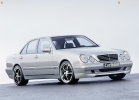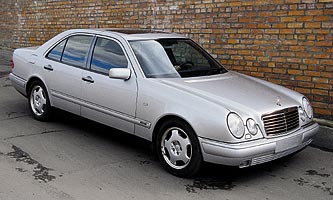Test drive Mercedes Benz E-class w210 1999-2002 sedan
Success recipe
Despite the fact that the latest generation of the last generation of Mercedes E-class took place more than five years ago, this model is still extremely high in demand around the world, including in Belarus. To say that Mercedes E -class is unusually popular is to say nothing. The emergence of a personal popular nickname - the eyes -play - may indicate the popularity and universal recognition of the model.More than a million E-class cars, wrapping kilometers on their wheels along the roads of the whole world, convincingly prove that, having at one time going to such a risky step as a change in design, the German automaker did not lose. In terms of sales, Eshka has long been leading in her class, and not only in her homeland. But time does not stand still, and competitors are not asleep, so in order to consolidate the success of their bestseller, four years later they are restored - a small modernization aimed at increasing consumer qualities and improving some indicators. True, only a large special for cars, or the owner of a similar Merce, can distinguish the updated Eshka from the 1995 model.
External changes, to the joy of most fans of the model, came down to easy facelifting - they slightly changed the shape of the rear lights, a fake radiator, the headlights themselves. The new pseudo-sports front bumper and repeaters of turns indicators located in the hulls of rear-view mirrors, as is done in new S- and C-class mirrors, are much more striking. But the interior of the new E-Class has undergone the most changes. In total, 1800 details were subjected to the audit, although this is not visible by eye. But the most interesting in the updated E-class is under the hood. More recently, a new line of gasoline and diesel engines was proposed for this model.
Under the sign of CDI
The special pride of engineers is now an American -German concern - the latest diesel engines with direct fuel injection, which carry the abbreviation CDI. The latest trend in the world of cars is that manufacturers are increasingly turning their eyes towards diesel engines, and if the majority of four-, maximum six -cylinder engines, now even eight -cylid power units are limited, even surpassing their torque even superior to their moment gasoline counterparts! The top model is, of course, a 4.0-liter 250-horsepower V8, offered for S- and G-class cars. They don’t put such a motor on Eshka, and this is not necessary: \u200b\u200bthe E320 CDI version, developing 197 hp, provides the machine with more than worthy characteristics. For example, the notorious acceleration from a place to a hundred takes 8.3 (!) A second, and the maximum speed is 230 km/h, which is only 8 km/h less than the 3.2-liter gasoline version. That is, what happens: in terms of characteristics - an almost equivalent replacement for a gasoline analogue, but what a fuel saving! Anyway, there are people who just like to ride powerful cars with turbodiesel engines. After all, the main horse of modern CDI, in addition to saving fuel, is an incredible moment, and literally with idle revolutions. The same 320 CDI develops its incredible 470 Nm in the range of 1800-2600 rpm, which is very significant. Acceleration begins instantly, and not from the moment when the arrow of the tachometer reaches the green zone. A slightly smaller, but also incredibly large, especially when compared with gasoline engines, a five-cylinder 170-horsepower 270 CDI has a five-cylinder torque of 370 Nm. In its characteristics (9.0 seconds from a place to hundreds and a maximum speed of 225 km/h), it does not far behind the 320 CDI flagship, but at the same time more accessible and economical. Although it is a sin to complain about voracity to the owners of both versions: the more powerful 320th average fuel consumption is 7.8 l/100 km, and 270 CDI generally consumes 7.2 l/100 km! Have you yet forgotten that we are talking about cars that can quickly move in the left row of an autobahn?
A new basic version was also a big surprise for fans of the model - E200, which is now being written with the Kompressor prefix. Yes, the most affordable version of the Mercedes-Benz E-class is now equipped with a mechanical supercharger, which allows you to remove a power of 163 hp from a relatively small working volume. Which, in turn, makes the car quite fast. The maximum version of the version with a mechanical six -speed gearbox, which is standard for modification of the E200 Kompressor, is 222 km/h (with an automatic machine - 219 km/h), while acceleration to all hundreds occupies 9.7 seconds (automatic - automatic - automatic 10.2). But the most important thing is that such a fairly powerful car consumes fuel at the model level of the class below. The average fuel consumption is 9.0 l/ 100 km in a version with mechanics and 10.2 l/ 100 km - with automatic, five -speed, by the way, a gearbox. In addition to increased power engines, updated Mercedes E received a whole set of active and passive safety tools as standard equipment, such as the ESP electronic stabilization system and the novelty - window inflatable airbags that can protect the driver and passenger even with strong lateral clashes. To the previously available electric windows, electric drives of mirrors, air conditioning and the central castle are now added electric drives of seats, which, if desired, can be ordered with ventilation.
Pavel Kozlovsky









